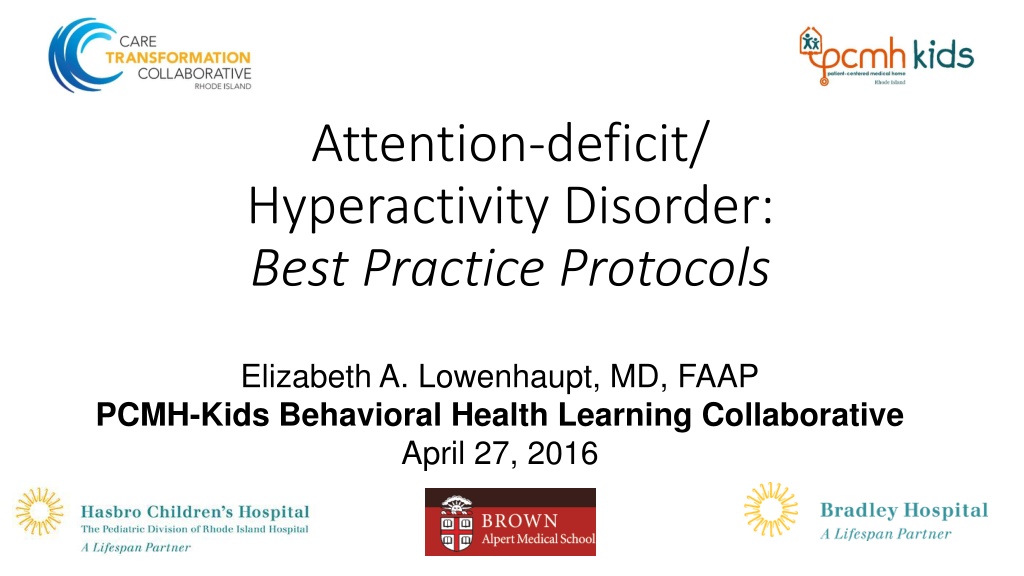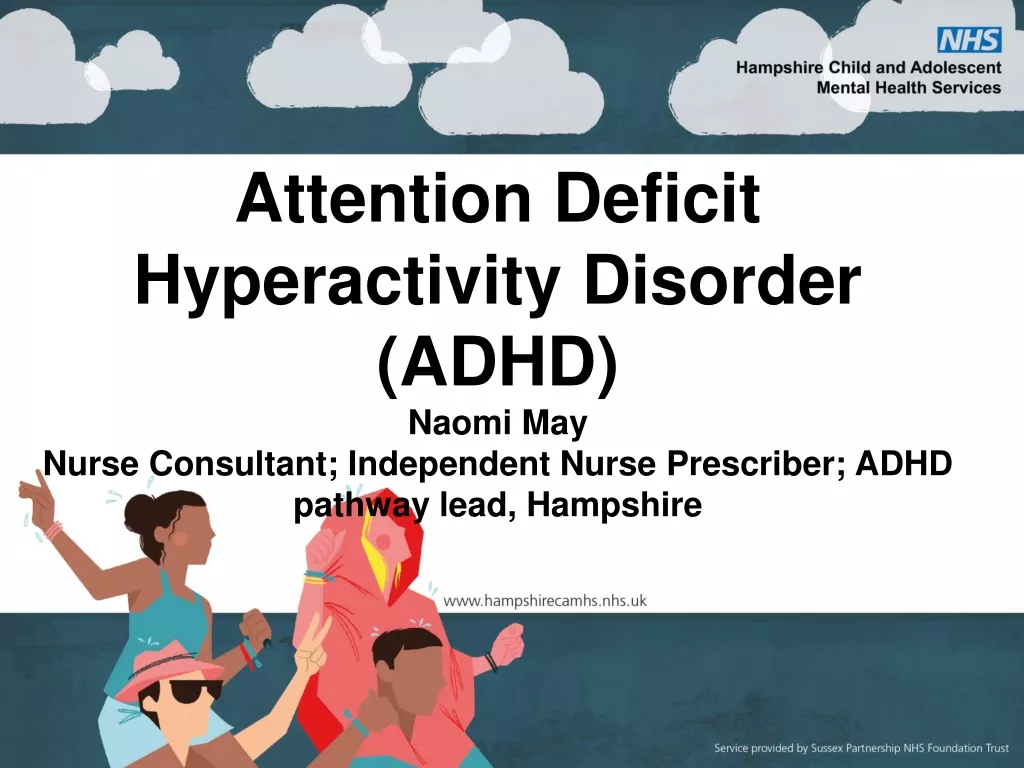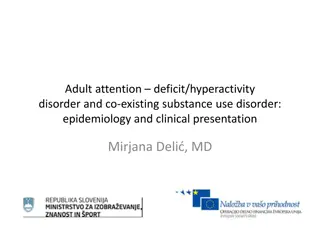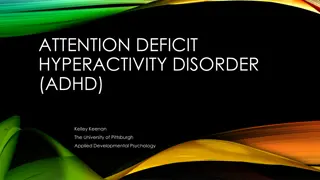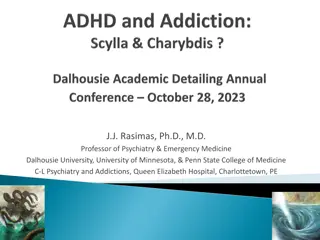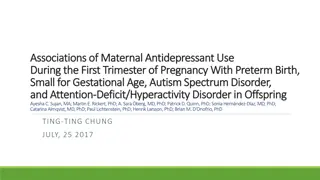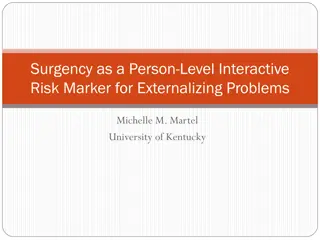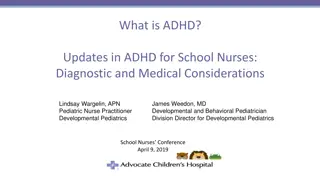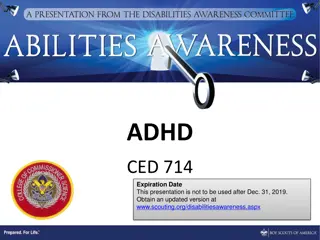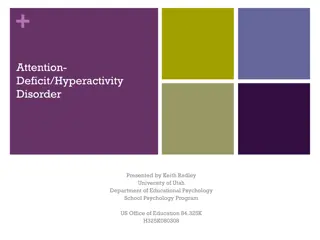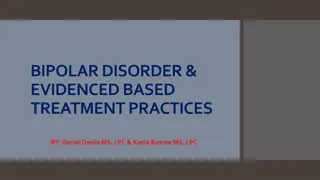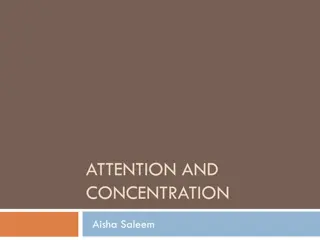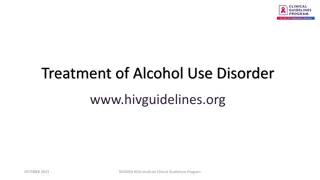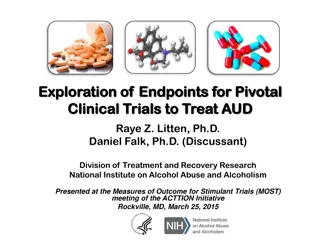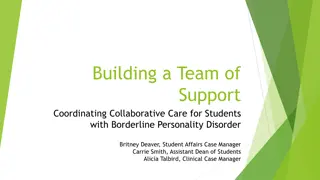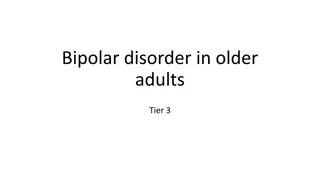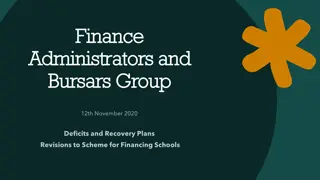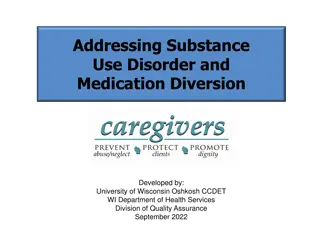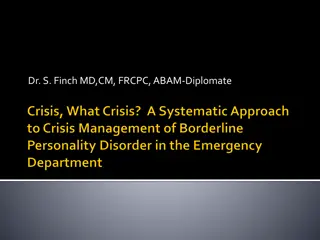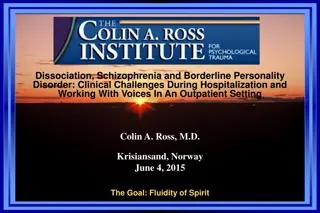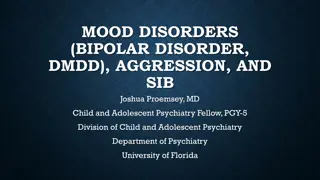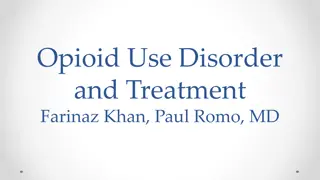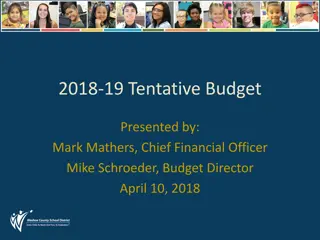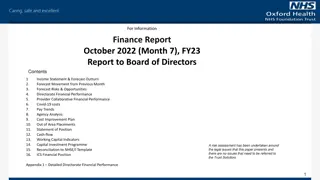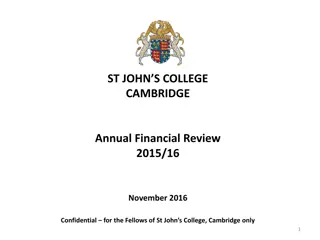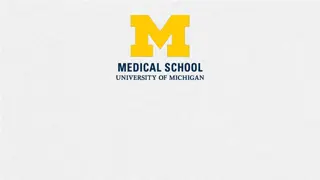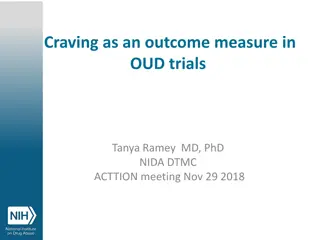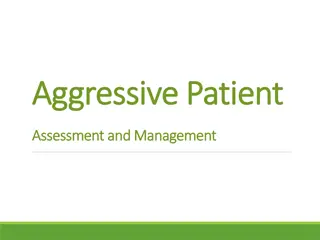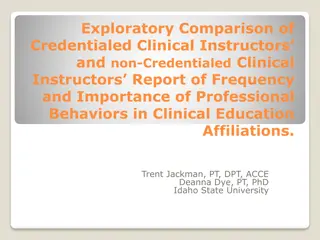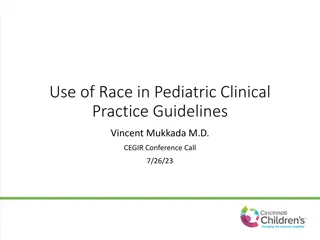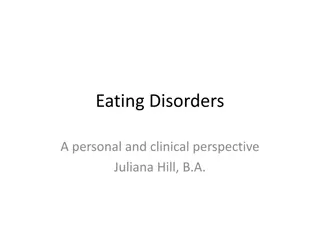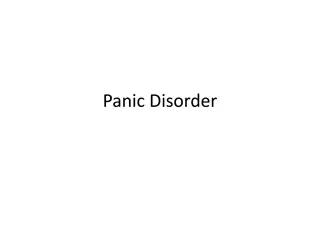Best Practices for Attention-Deficit/Hyperactivity Disorder: Clinical Guidelines & Resources
This presentation outlines best practices for diagnosing and treating Attention-Deficit/Hyperactivity Disorder (ADHD) in children and adolescents. It covers clinical practice guidelines from the American Academy of Pediatrics and the American Academy of Child & Adolescent Psychiatry and provides resources for providers, patients, and families. The content includes discussions on off-label medication use and references important protocols established for managing ADHD.
Download Presentation

Please find below an Image/Link to download the presentation.
The content on the website is provided AS IS for your information and personal use only. It may not be sold, licensed, or shared on other websites without obtaining consent from the author. Download presentation by click this link. If you encounter any issues during the download, it is possible that the publisher has removed the file from their server.
E N D
Presentation Transcript
Attention-deficit/ Hyperactivity Disorder: Best Practice Protocols Elizabeth A. Lowenhaupt, MD, FAAP PCMH-Kids Behavioral Health Learning Collaborative April 27, 2016
DISCLOSURE DISCLOSURE The commercial entities with which I/we have relationships do not produce health-care related products or services relevant to the content I am presenting. This presentation does include discussion of medication use which is off-label , which I will identify as such.
GOALS To provide resources and references for providers, patients, and their families; To review the clinical practice guidelines/(parameters) established by the American Academy of Pediatrics (and American Academy of Child & Adolescent Psychiatry) for the assessment and treatment of attention-deficit/hyperactivity disorder; and To set the scene for more in-depth case discussion to follow.
RESOURCES American Academy of Pediatrics (AAP) Clinical Practice Guideline http://pediatrics.aappublications.org/content/pediatrics/early/2011/10/14/ peds.2011-2654.full.pdf American Academy of Child & Adolescent Psychiatry (AACAP) Practice Parameter http://www.jaacap.com/article/S0890-8567(09)62182-1/pdf AACAP ADHD Resource Center http://www.aacap.org/AACAP/Families_and_Youth/Resource_Centers/ADHD _Resource_Center/Home.aspx Parent Medication Guide (AACAP, APA) http://www.parentsmedguide.org/parentguide_english.pdf
REFERENCES AAP Clinical Practice Guideline ADHD: Clinical practice guideline for the diagnosis, evaluation, and treatment of attention-deficit/hyperactivity disorder in children and adolescents (2011). Pediatrics: 128 (5), pp. 1 16. AACAP Practice Parameter Practice parameter for the assessment and treatment of children and adolescents with attention-deficit/hyperactivity disorder (2007). JAACAP, 46 (7): 894-921. Distributed article Southammakosane, C & Schmitz K (2015). Pediatric psychopharmacology for treatment of ADHD, depression, and anxiety. Pediatrics, 136 (2): 351-359.
American Academy of Pediatrics: Clinical Practice Guideline Published in 2000 (recommendations for diagnosis & evaluation) Published in 2001 (recommendations for treatment) Revised in 2011 Intended to be integrated with broader algorithms developed as part of the mission of the AAP Task Force on Mental Health Based on multilevel, systematic review of the literature as evidence base for both diagnosis & treatment Acknowledges implementation challenges (payment and time, access to mental health clinicians, cultural differences, etc.)
American Academy of Pediatrics: Clinical Practice Guideline ACTION STATEMENTS The primary care clinician should .
American Academy of Pediatrics: Clinical Practice Guideline ACTION STATEMENTS The primary care clinician should . 1. Initiate an evaluation for ADHD for any child 4 through 18 years of age who presents with academic or behavioral problems and symptoms of inattention, hyperactivity, or impulsivity
American Academy of Pediatrics: Clinical Practice Guideline ACTION STATEMENTS The primary care clinician should . 1. Initiate an evaluation for ADHD for any child 4 through 18 years of age who presents with academic or behavioral problems and symptoms of inattention, hyperactivity, or impulsivity 2. Determine that DSM-IV criteria have been met
American Academy of Pediatrics: Clinical Practice Guideline ACTION STATEMENTS The primary care clinician should . 1. Initiate an evaluation for ADHD for any child 4 through 18 years of age who presents with academic or behavioral problems and symptoms of inattention, hyperactivity, or impulsivity 2. Determine that DSM-IV criteria have been met 3. Include assessment for other conditions that might coexist with ADHD
American Academy of Pediatrics: Clinical Practice Guideline ACTION STATEMENTS The primary care clinician should . 1. Initiate an evaluation for ADHD for any child 4 through 18 years of age who presents with academic or behavioral problems and symptoms of inattention, hyperactivity, or impulsivity 2. Determine that DSM-IV criteria have been met 3. Include assessment for other conditions that might coexist with ADHD 4. Recognize ADHD as a chronic condition
American Academy of Pediatrics: Clinical Practice Guideline ACTION STATEMENTS The primary care clinician should . 1. Initiate an evaluation for ADHD for any child 4 through 18 years of age who presents with academic or behavioral problems and symptoms of inattention, hyperactivity, or impulsivity 2. Determine that DSM-IV criteria have been met 3. Include assessment for other conditions that might coexist with ADHD 4. Recognize ADHD as a chronic condition 5. Consider treatment based on patient s age
American Academy of Pediatrics: Clinical Practice Guideline ACTION STATEMENTS The primary care clinician should . 1. Initiate an evaluation for ADHD for any child 4 through 18 years of age who presents with academic or behavioral problems and symptoms of inattention, hyperactivity, or impulsivity 2. Determine that DSM-IV criteria have been met 3. Include assessment for other conditions that might coexist with ADHD 4. Recognize ADHD as a chronic condition 5. Consider treatment based on patient s age 6. Titrate doses of medication to achieve maximum benefit with minimum adverse effects
American Academy of Pediatrics: Clinical Practice Guideline ACTION STATEMENTS
American Academy of Pediatrics: Clinical Practice Guideline ACTION STATEMENTS The primary care clinician should . 1. Initiate an evaluation for ADHD for any child 4 through 18 years of age who presents with academic or behavioral problems and symptoms of inattention, hyperactivity, or impulsivity
ADHD Evaluation Patient/parent interview Standardized behavior rating scales (patient, parent, and/or teacher) EXAMPLES: ADHD Rating Scale Child Behavior Checklist (CBCL) Conners Parent/Teacher Rating Scale-Revised Conners Wells Adolescent Self-Report Scale Swanson, Nolan, and Pelham (SNAP-IV) Vanderbilt ADHD Diagnostic Parent/Teacher Scales
ADHD Evaluation Psychological testing if academic impairment seems unrelated to ADHD or in addition to it Assessment of intellectual ability (IQ) Academic achievement testing Further work-up may be recommended following psychological testing Neuropsychological testing Speech-language assessment
American Academy of Pediatrics: Clinical Practice Guideline ACTION STATEMENTS The primary care clinician should . 1. Initiate an evaluation for ADHD for any child 4 through 18 years of age who presents with academic or behavioral problems and symptoms of inattention, hyperactivity, or impulsivity 2. Determine that DSM-IV criteria have been met
DSM-5 (effective May, 2013) Changes to ADHD from DSM-IV Diagnostic criteria similar same 18 symptoms divided into two symptom domains (inattention and hyperactivity/impulsivity), at least six symptoms in one domain required Presentation specifiers instead of sub-types (but same ones)
DSM-5 (effective May, 2013) ADHD Sub-types Presentations Presentations Combined symptoms of both inattention and hyperactivity-impulsivity for past 6 months Predominantly Inattentive symptoms of inattention but not hyperactivity-impulsivity for past 6 months Predominantly Hyperactive-Impulsive symptoms of hyperactivity-impulsivity but not inattention for past 6 months
DSM-5 (effective May, 2013) ADHD Diagnostic Criteria Symptoms in one category or both Minimum number of symptoms over past 6 months 6 or more up to age 16 5 or more ages 17 and older Inappropriate for developmental level Disruptive (if hyperactive-impulsive symptoms)
DSM-5 (effective May, 2013) ADHD Diagnostic Criteria Hyperactive-impulsive presentation: Fidgets with hands or feet or squirms in chair Has difficulty remaining seated Runs about or climbs excessively in children; extreme restlessness in adults Difficulty engaging in activities quietly Acts as if driven by a motor; adults will often feel inside like they were driven by a motor Talks excessively Blurts out answers before questions have been completed Difficulty waiting or taking turns Interrupts or intrudes upon others
DSM-5 (effective May, 2013) ADHD Diagnostic Criteria Hyperactive-impulsive presentation: Fidgets with hands or feet or squirms in chair Has difficulty remaining seated Runs about or climbs excessively in children; extreme restlessness in adults Difficulty engaging in activities quietly Acts as if driven by a motor; adults will often feel inside like they were driven by a motor Talks excessively Blurts out answers before questions have been completed Difficulty waiting or taking turns Interrupts or intrudes upon others Inattentive presentation: Fails to give close attention to details or makes careless mistakes Has difficulty sustaining attention Does not appear to listen Struggles to follow through on instruction Has difficulty with organization Avoids or dislikes tasks requiring a lot of thinking Loses things Is easily distracted Is forgetful in daily activities.
DSM-5 (effective May, 2013) Changes to ADHD from DSM-IV Cross-situational requirement strengthened to several symptoms in each setting Onset now several inattentive or hyperactive-impulsive symptoms were present prior to age 12 (as compared to 7) Co-morbid diagnosis with autism allowed Adult diagnosis threshold lowered to only five symptoms Examples added to criterion items to facilitate application across lifespan Location in DSM-5 - placed in neurodevelopmental disorders chapter
American Academy of Pediatrics: Clinical Practice Guideline ACTION STATEMENTS The primary care clinician should . 1. Initiate an evaluation for ADHD for any child 4 through 18 years of age who presents with academic or behavioral problems and symptoms of inattention, hyperactivity, or impulsivity 2. Determine that DSM-IV criteria have been met AND rule-out alternative causes
ADHD Differential Diagnosis Underlying medical conditions Traumatic brain injury Encephalopathy Metabolic abnormality (e.g. hyperthyroidism) Toxic exposure (e.g. lead exposure, fetal alcohol syndrome, etc.) Other developmental disorders Learning or language disorder Autism spectrum disorder Sleep disorder Other psychiatric disorders Anxiety, depression, or other mood disorders Psychotic disorders Substance use disorders Trauma and/or psychosocial stressors
American Academy of Pediatrics: Clinical Practice Guideline ACTION STATEMENTS The primary care clinician should . 1. Initiate an evaluation for ADHD for any child 4 through 18 years of age who presents with academic or behavioral problems and symptoms of inattention, hyperactivity, or impulsivity 2. Determine that DSM-IV criteria have been met 3. Include assessment for other conditions that might coexist with ADHD
ADHD Co-Morbidity Emotional/behavioral disorders Anxiety Depression Oppositional defiant Conduct Substance use Developmental disorders Learning Language Other neurodevelopmental disorders (autism, etc.) Physical conditions Tics Sleep apnea
American Academy of Pediatrics: Clinical Practice Guideline ACTION STATEMENTS The primary care clinician should . 1. Initiate an evaluation for ADHD for any child 4 through 18 years of age who presents with academic or behavioral problems and symptoms of inattention, hyperactivity, or impulsivity 2. Determine that DSM-IV criteria have been met 3. Include assessment for other conditions that might coexist with ADHD 4. Recognize ADHD as a chronic condition
ADHD Recognize as a chronic condition Follow principles of chronic care model and medical home Consider issues of treatment compliance Possibility that parent may also have ADHD Ongoing bidirectional communication, collaborative goal-setting, etc. Patient Parent Teacher/school Mental health providers
American Academy of Pediatrics: Clinical Practice Guideline ACTION STATEMENTS The primary care clinician should . 1. Initiate an evaluation for ADHD for any child 4 through 18 years of age who presents with academic or behavioral problems and symptoms of inattention, hyperactivity, or impulsivity 2. Determine that DSM-IV criteria have been met 3. Include assessment for other conditions that might coexist with ADHD 4. Recognize ADHD as a chronic condition 5. Consider treatment based on patient s age
ADHD Treatment Behavior therapy School programming and supports Medication FDA-approved off label Treatment of co-morbidity Treatment of parents
ADHD Treatment (varies by age) Preschool (4-5 years) School-aged (6-11 years) Adolescent (12 18 years)
ADHD Treatment (varies by age) Preschool (4-5 years) First-line treatment = evidence-based parent- and/or teacher-administrated behavior therapy Consider medication if no significant improvement AND moderate-to-severe disturbance in function OR if benefits outweigh risks when no behavior therapy available Best evidence for methylphenidate FDA approval only for dextroamphetamine Lower doses needed due to side effects Concern for decreasing growth velocity (worst during first 2 years of treatment, total range of 1-2 cm)
ADHD Treatment (varies by age) School-aged children (6-11 years) Recommend FDA-approved medication AND evidence-based parent- and/or teacher-administered behavior therapy Either one ok on its own Include school program/placement as part of treatment plan
ADHD Treatment (varies by age) Adolescent (12-18 years) Recommend FDA-approved medication AND evidence-based parent- and/or teacher-administered behavior therapy Medication alone ok Assess for symptoms of substance abuse Consider in making diagnosis Consider in recommending treatment POTENTIAL FOR ABUSE/DIVERSION Consider risks for driving when developing medication treatment plan
ADHD Treatment Behavior therapy School programming and supports Medication FDA-approved off label Treatment of co-morbidity Treatment of parents
ADHD Treatment Behavior therapy School programming and supports Medication FDA-approved off label Treatment of co-morbidity Treatment of parents
ADHD Treatment Behavior therapy Parent- or teacher- training techniques (often taught in group format) Evidence-based treatments: Behavioral parent training (BPT) Behavioral classroom management Behavioral peer interventions (BPI) May be used alone or in conjunction with medication
ADHD Treatment Behavior therapy School programming and supports Medication FDA-approved off label Treatment of co-morbidity Treatment of parents
ADHD Treatment Behavior therapy School programming and supports Medication FDA-approved off label Treatment of co-morbidity Treatment of parents
ADHD Treatment Medication FDA-approved Stimulants (most effective) Non-stimulants (less effective) off label
ADHD Treatment (Medications FDA-approved) STIMULANTS Classes: Amphetamine Methylphenidate Long-acting vs. short-acting Dosing parameters* Side effects & management* *reviewed in detail in Pediatric Psychopharmacology reference or AAP Clinical Practice Guideline Supplemental materials
ADHD Treatment (Medications FDA-approved) STIMULANTS: side effects Most common Appetite loss Abdominal pain Headaches Sleep disturbance Decreasing growth velocity Uncommon but severe Hallucinations & psychosis Sudden cardiac death Mood lability & dysphoria (preschool)
ADHD Treatment (Medications FDA-approved) NON-STIMULANTS Best evidence from top to bottom: 1) Atomoxetine (selective norepinephrine-reuptake inhibitor) 2) *Extended-release guanfacine (selective alpha-2-adrenergic agonist) 3) *Extended-release clonidine (selective alpha-2-adrenergic agonist) *Evidence to support efficacy as mono-therapy OR adjunctive therapy
ADHD Treatment (Medications FDA-approved) NON-STIMULANTS: side effects Atomoxetine Somnolence GI symptoms (including decreased appetite) Suicidal ideation (Black Box Warning) Hepatitis (rare) Alpha-2 agonists Somnolence (esp. clonidine) Dry mouth Hypotension (or hypertension on sudden discontinuation)
ADHD Treatment Behavior therapy School programming and supports Medication FDA-approved off label Treatment of co-morbidity Treatment of parents
American Academy of Pediatrics: Clinical Practice Guideline ACTION STATEMENTS The primary care clinician should . 1. Initiate an evaluation for ADHD for any child 4 through 18 years of age who presents with academic or behavioral problems and symptoms of inattention, hyperactivity, or impulsivity 2. Determine that DSM-IV criteria have been met 3. Include assessment for other conditions that might coexist with ADHD 4. Recognize ADHD as a chronic condition 5. Consider treatment based on patient s age 6. Titrate doses of medication to achieve maximum benefit with minimum adverse effects
ADHD Treatment (Medication Management Tips) Starting class, formulation, and dose based on age, symptom pattern, insurance reimbursement Can titrate every 3-7 days at first Titrate to maximum doses that control symptoms without adverse effects
ADHD Treatment (Medication Management Tips) Routine monitoring for benefits and adverse effects Follow-up visits (initially every 30 days) Phone availability for questions/concerns Refill plan (including consideration of controlled substance) Reassessment with parents & school (verbal communication, rating scales, etc.)
